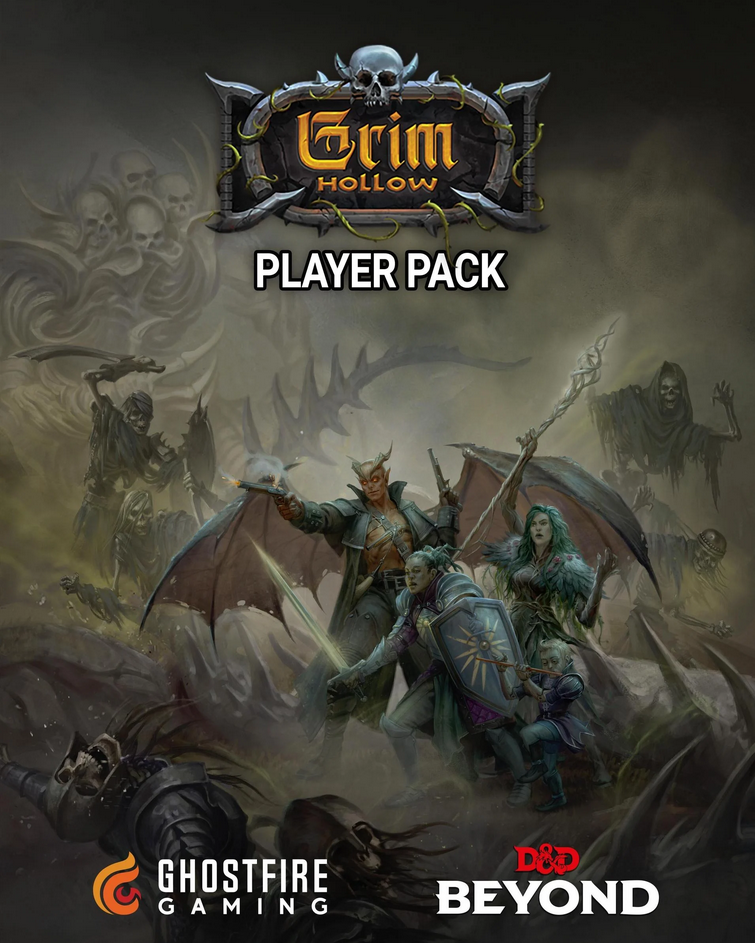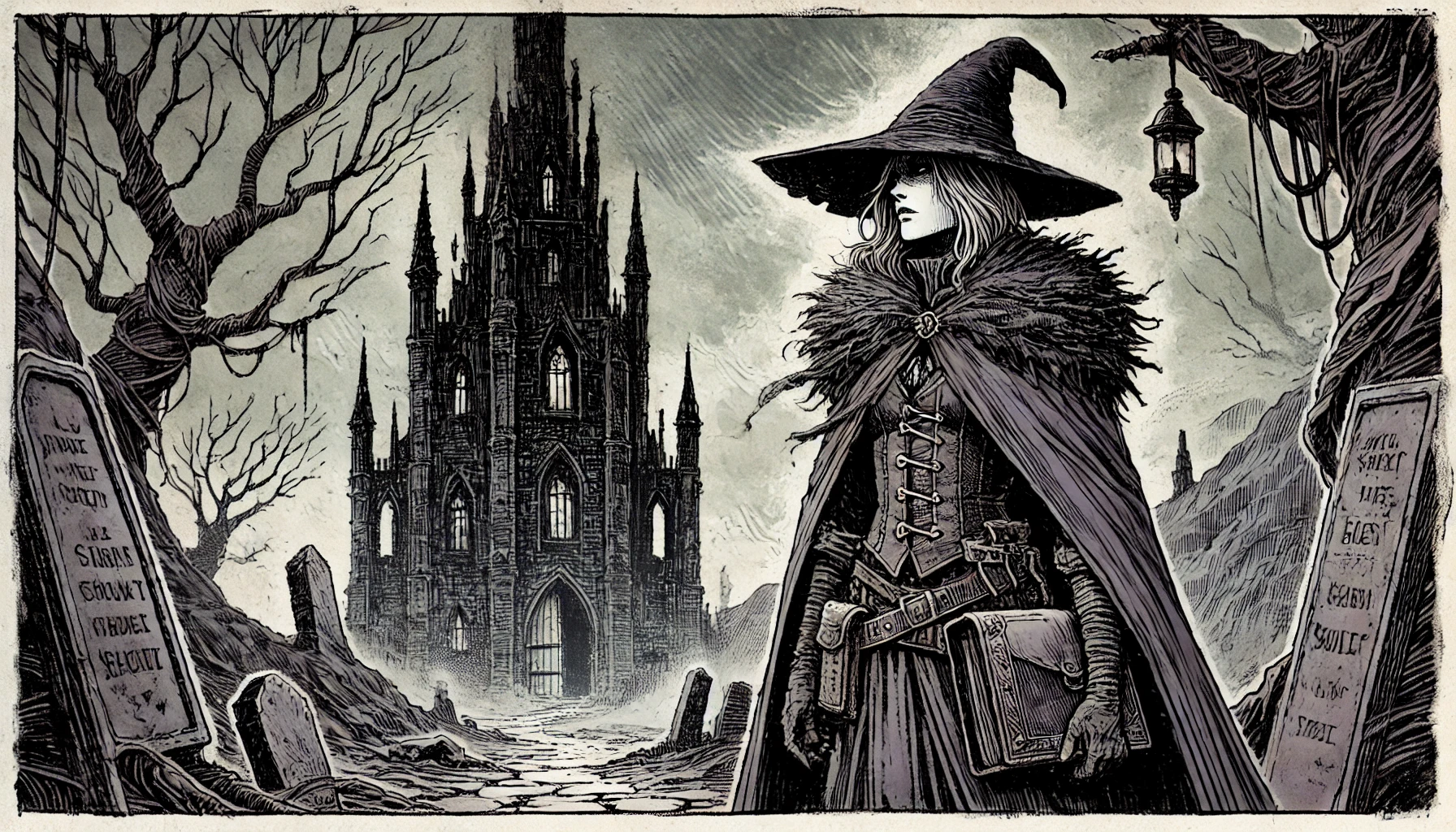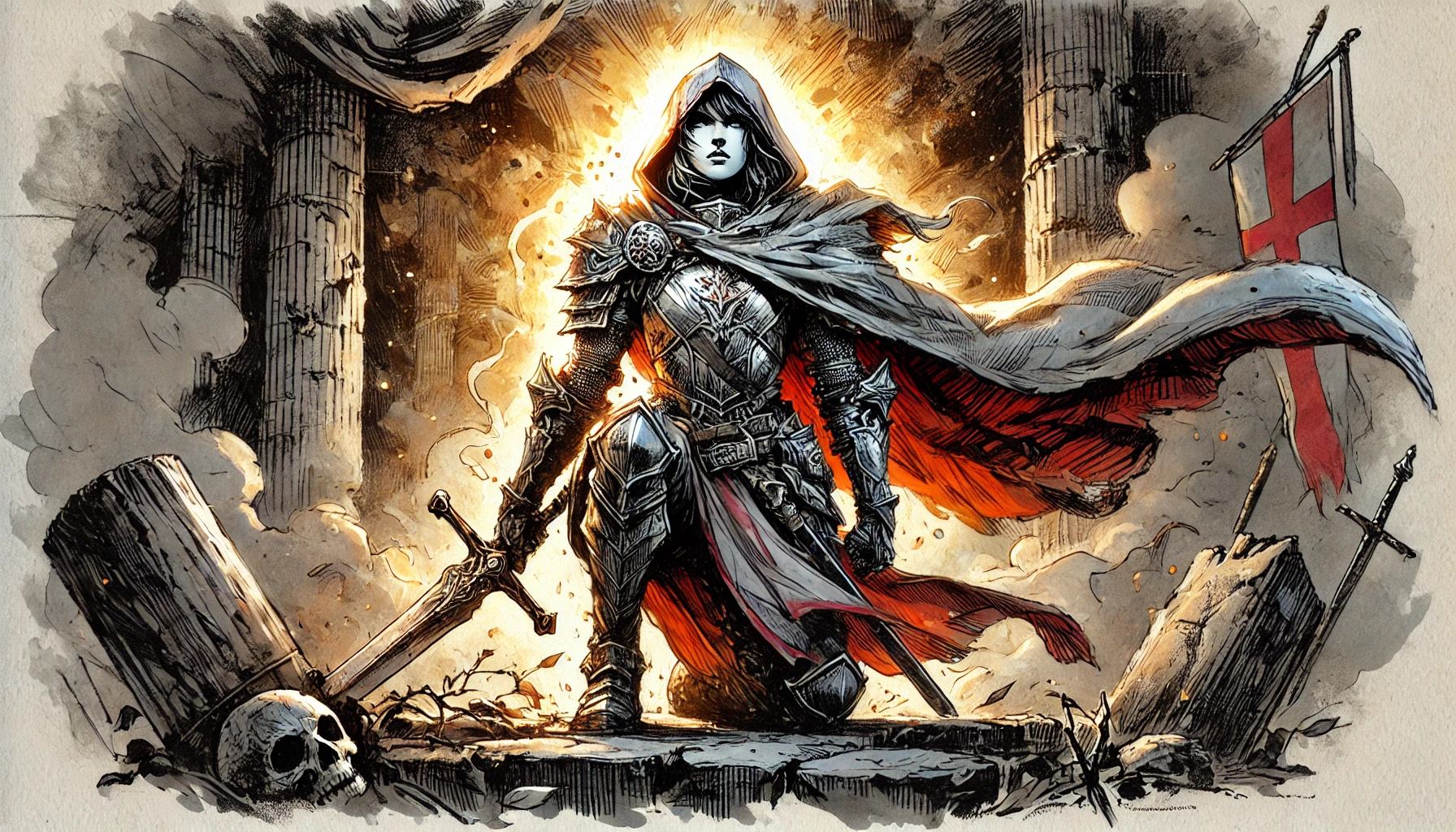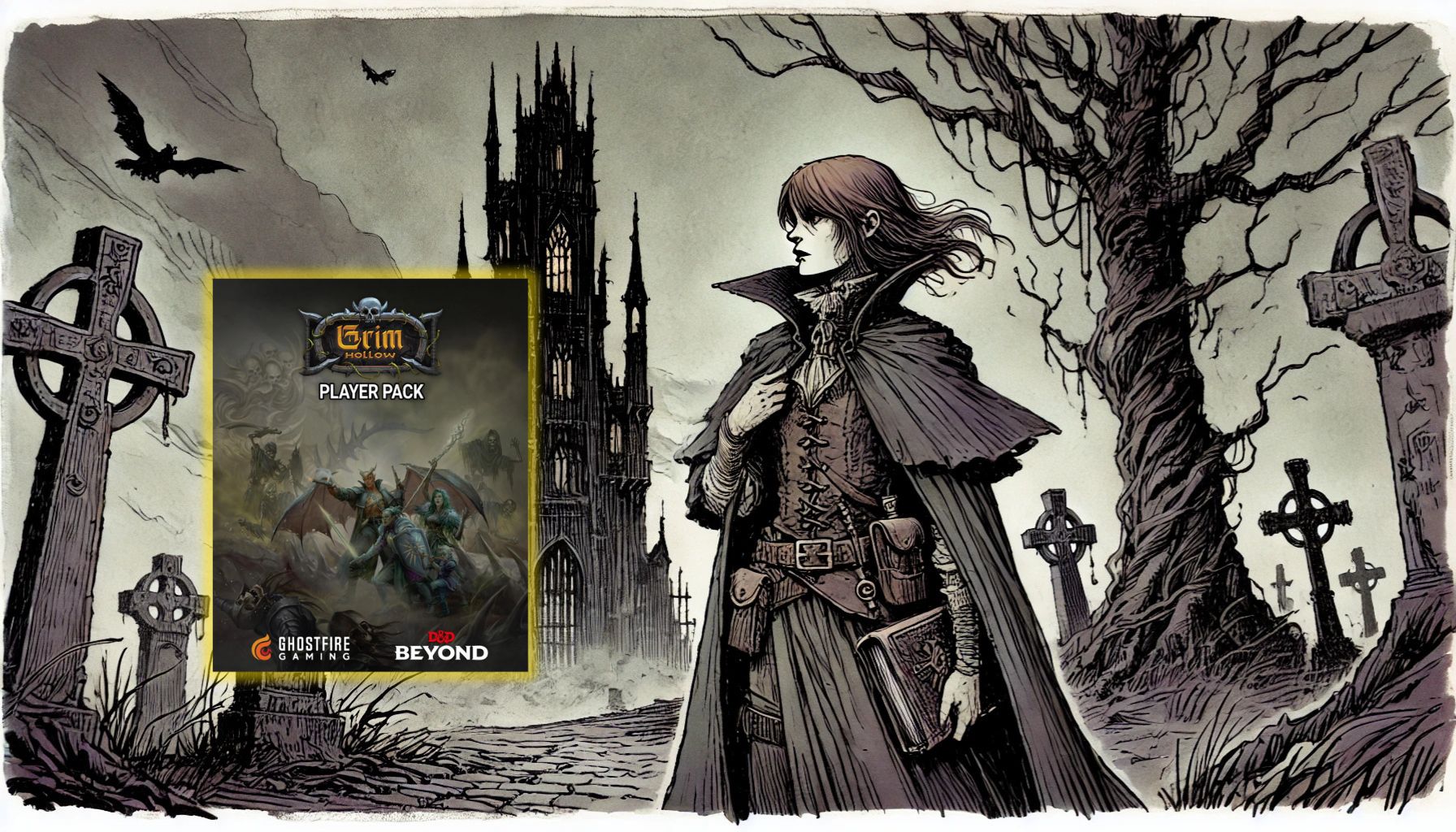Step into the gloom of Etharis, and you’ll quickly discover why Grim Hollow is frequently whispered about in dimly lit taverns and around gaming tables populated by dungeon masters with a flair for the macabre. In the crowded landscape of D&D-compatible settings, Grim Hollow’s vision stands among the most arresting: here is a world brimming with dread, where every shadow carries the weight of loss, and hope isn’t just scarce—it’s preyed upon. With the release of the 2025 Player Pack on D&D Beyond, this shadow-soaked universe opens wider than ever, inviting a new legion of adventurers to taste the bittersweet fruits of dark fantasy. This is not the arrival of a brand-new world, but rather a calculated, invigorating expansion—one that handpicks the essential notes of grimdark and amplifies them through robust subclass design, chilling new magic, and a clutch of evocative playable species.
If you’re a player seeking a land that lures you with moral ambiguity, where virtue can become vice, and every gain exacts a cost, Etharis is your proving ground. The new digital supplement doesn’t seek to rewrite the tome of Grim Hollow. Instead, it acts as alchemist, distilling new mechanical options and fresh flavors for characters, but never at the expense of the world’s somber, fatalistic heart. It’s a love letter to players who crave more than swordplay—they want stories scarred by regret, redemption, and transformation.
Grim Hollow’s enduring appeal flows from its brutal worldbuilding. Etharis, far from the breezy optimism of more traditional D&D settings, contorts every rule and narrative arc until the stakes bleed through. The expansion leans hard into this theme, drenching subclass powers and spell effects in the language of entropy, sorrow, and survival. The Player Pack on D&D Beyond emerges as one of 2025’s significant digital releases not just for its quantity of content, but for how tightly it wounds that content around the pulse of the setting.
This review will peer into the interplay between new subclasses and the haunted world that gave them birth. Subclass mechanics, setting integration, and thematic resonance form the three-pronged standard by which these digital offerings stand or fall. Through that lens, we’ll explore whether the expansion deepens the gloom of Etharis…and whether that darkness is worth braving.
So don your iron talismans and keep your torch close: the 2025 Player Pack invites us deeper into the shadows. Let’s see if what we find there is truly worth the risk.
The Etharis Setting: Bleak, Gothic, and Unrelenting
Etharis is not a backdrop—it’s a crucible. The world-building here broods with gothic abandon, evoking the desolate splendor of ruined cathedrals, corpse-choked battlefields, and cities whose very stones seem to mourn the empires that have fallen before. Clearly influenced by grimdark fantasy, Gothic horror, European plague history, and the perpetual twilight of fallen civilizations, Etharis is a love letter to those who find beauty in decay.
The tone of Grim Hollow campaigns is palpable, relentless, and often bleak. Stories unfold under a shroud of perpetual jeopardy; death is never far, and trust is a currency that devalues by the hour. Hope flickers, but rarely blazes. Mystery gnaws at the marrow of every scene: the secrets of a ruined monastery, the true parentage of a haunted noble, infectious plagues that twist both flesh and mind. It is a mystery that never tolerates easy answers.
What makes Etharis remarkable is how this darkness moves beyond the narrative and soaks into the ruleset itself. Wounds are lasting, magical cures rare or incomplete, and even simple acts of travel or negotiation carry the possibility of horrible loss. The new expansion doesn’t shy from this: mechanical elements like fear, exhaustion, lingering injuries, and resource attrition are not abstract—they are front and center, shaping the behaviors and mindsets of both DM and players. Here, the setting’s cruelty isn’t just for flavor; it’s a lived, mechanical reality.
The world of Etharis can drive a campaign’s trajectory as much as its villains or artifacts. Plagues, religious schisms, ancient curses—all are designed to test characters’ mettle. Not in the classic hero-versus-evil sense, but in the way real people are tested by adversity: do you become monstrous to survive, or do you cling to the values of a world now dead? In that tension, every story becomes unique…and unforgettable.
| Category | Etharis Example | Forgotten Realms Equivalent | Gameplay Effect |
|---|---|---|---|
| Governance | Plague-ridden Oligarchies, Tyrants | Lords’ Alliance, Monarchs | Limits PC influence, law is corrupt or absent |
| Religion | Schismatic Churches, Fanatical Cults | Pantheon of Good/Evil | Faith grants little comfort; divine power is suspect |
| Magic | Feared, Restricted; Witches Hunted | Arcane Brotherhood, Open | Magic use dangerous, societal suspicion, stricter laws |
| Population | War-torn, Shrinking, Distrustful Villages | Bustling, Growing Cities | Harder to find allies, resources, or refuge |
| Cosmic Threats | Curses, Liches, Plagues, Forsaken Gods | Dragons, Demons, Drow | Threats feel inescapable, focused on suffering & entropy |
| Tone/Atmosphere | Hopeless, Grim, Gothic Decay | Heroic, High Fantasy | Survival focus, complex choices, darkness pervades |
The cohesiveness of Grim Hollow’s subclasses and items depends on this world-to-rule harmony. The abilities you wield only matter as much as the stakes that surround them, and in Etharis, every bonus or spell comes tangled with consequence. The tone of the setting is the crucible in which subclass and item design are forged—remove it, and much of the content loses its razor edge.
To truly appreciate the Player Pack’s innovations, one must first immerse themselves in Etharis’ particular flavor of sorrow. The powers, artifacts, and even new species only shine when brought into relief by the world they’re meant to haunt. It’s cohesion—between dread, hope, and raw mechanical consequence—that makes Grim Hollow sing in a register all its own.

The Six New Subclasses: Grim by Design
The Path of the Carrion Raven Barbarian does not rage in the way of primal tradition; instead, they channel the vulture’s patience and the death’s-head raven’s cunning. When their blood stirs, necrotic energies whip around them, turning their fury into palpable fear—enemies feel the cold of a hundred dying wings. With abilities that trigger on the defeat of foes, raven-form transformations, and brief, feathered flights over the battlefield, this subclass transforms mortality into momentum.
The College of Requiems Bard is a maestro of mourning, threading spells through dirges and laments. Their signature moves likely let them interfere with the cusp of death—boosting allies’ death saves, sapping joy from survivors, and animating tales of the dearly departed. When these bards play, the recently dead answer, and the living tremble. Their art is equal parts terror and hope, a performance on the razor’s edge between despair and renewal.
The Inquisition Domain Cleric is the night terror of sinners and heretics. Their faith is merciless, weaponizing forced confessions and blinding radiance as punishments rather than blessings. Mechanically, they might demand Wisdom saves or bewitch enemies into revealing secrets, their spells enforcing order through psychological agony and radiant nemesis damage. Inquisition Clerics thrive when rooting out threats both supernatural and political, blurring the line between redeemer and oppressor.
The Blade Breaker Fighter defines resistance incarnate. These warriors shatter weapons as a signature move, drive back attackers with ripostes, and hold the line even when hope splinters. They’re tacticians of the desperate hour, excelling at controlling enemy placement and robbing foes of their arms with well-timed sunder maneuvers. On the battlefield, their mere presence warps the flow of violence—not with showy power, but with grinding, calculated defiance.
The Oath of Zeal Paladin is Grim Hollow’s answer to the storm front fanatic. Their smites burn with the fuel of self-sacrifice, escalating in power as their wounds deepen or as allies fall. Their auras don’t offer gentle comfort, but flaming fanaticism, driving themselves and others to impossible acts. These paladins refuse surrender, channeling martyrdom as weapon and shield against the night.
The Misfortune Bringer Rogue is a saboteur of luck itself, twisting fate knives in the backs of overconfident foes. Through features that manipulate dice outcomes, confer curses, or punish the overreliant, these rogues thrive on enemy blunders. Missed attacks or failed saves create delectable openings, letting the Misfortune Bringer turn disaster into opportunity with chilling efficiency.
Design & Thematic Notes on the Subclasses:
- Carrion Raven’s rage powers synergize with necrotic and death effects, enticing players who relish decay and transformation themes.
- Temporary raven transformations or flight invoke striking visuals and tactical options for creative play.
- Fear-based auras and intimidation stacking create moments where enemies scatter at the barbarian’s approach.
- College of Requiems empowers performers who savor pathos: manipulating death saves, channeling spirits, and sowing terror with songs.
- Necromantic musical abilities give Bards a funereal edge, resonating with both party support and battlefield control.
- Inquisition Domain Clerics excel in interrogations, imposing disadvantage with “guilt” effects and enforcing moral grayness.
- Their spells create consequences for lies or heresy, perfect for grim intrigue-heavy campaigns.
- Blade Breaker reimagines Fighters as counters rather than pure attackers: clever, reactive players will love weapon-smashing and forced repositioning.
- Battlefield control and disarm mechanics support locked-down, measured play over reckless aggression.
- Oath of Zeal Paladins wield escalating smite damage tied to self-sacrifice—ideal for group “face” or ideological zealots.
- Their auras enhance allies by stoking unyielding courage or even fanatic rage, pushing parties through the bleakest odds.
- Misfortune Bringer Rogues manipulate fate and dice, inflicting bad luck on key enemies and thriving on “cursed” rolls.
- Intervenes when both player and foe fail, attracting those who enjoy subverting standard success/failure paradigms.
- Subclasses all include mechanical callbacks to Etharis: plague theming, fateful curses, corruption, or martyr mechanic.
- Grim Hollow’s subclasses generally reward tactical thinking, risk-taking, and narrative-driven decision-making.
- Each class appeals to a niche fantasy: vulture-themed death, necromantic artistry, religious authoritarianism, counter-striking, zealous martyrdom, or cursed luck.
- Players who love moral ambiguity or tragic archetypes will find a subclass tailored just for them.
Taken as a whole, the 2025 subclass suite bristles with cohesion. Each one is sharpened for the setting: dark, evocative, steeped in the language of suffering and endurance. The mechanical balance appears thoughtfully considered—while some, like the College of Requiems and the Misfortune Bringer, present overtly potent tools, all are tempered by Etharis’s natural lethality and the ever-present cost of power.
Particular standouts, such as the Carrion Raven Barbarian and Inquisition Cleric, shine brightest in campaigns where narrative stakes match mechanical ones. None of these subclasses would truly flourish in a slapstick affair; rather, they’re custom cut for stories of heartbreak, conflict, and desperate survival. In dim-lit, morally murky campaigns, they truly take flight.
New Magic and Species in the Player Pack
Beyond subclasses, the Player Pack drops an array of grim-touched tools and talents: ten macabre magic items, two legendary artifacts, a spellbook’s worth of magic (ten new spells), and two new playable species stitched with tragic histories. In every case, the design revolves around amplifying Grim Hollow’s unique emotional and narrative pressure.
The ten magic items eschew traditional generics for deeply flavorful, often cursed, gear—the sort that dangles enormous power, but always at a psychological or physical price. From living cloaks that feed on blood to swords that whisper failed prophecies, each item is a temptation as well as a weapon. Players willing to risk corruption or social ostracism stand to gain the most.
Artifact weapons in the Player Pack are more than mere stat sticks. Each is a story engine unto itself—flaunting abilities that might slay a king but also doom the wielder. Expect weapons that demand ongoing sacrifice, perhaps draining life to spare the innocent, or invoking ancestral spirits to demand retribution for ancient crimes.
The suite of ten spells leans hard into the supernatural. Many foster the atmosphere: specter-summoning rituals, bloodletting wards, dire curses of famine or misfortune. Others—such as “Warding Dirge” or “Grim Harvest”—directly boost the setting’s stakes, returning life at a dark price, or forcing enemies to relive their worst memories.
The two new playable species round out the expansion’s roster. One hints at revenant ancestry—half-living, half-spirit, attuned to the threshold of death. The other is perhaps a breed of accursed outcasts, marked by plague or dark bargains. Both inject immediate story hooks and gritty, racial traits focused on survival, resilience, and social alienation.
Magic Items, Spells, and Species – Sample and Thematic Features:
- Vulture’s Mantle: Grants flight but drains a fraction of HP per use, its feathers growing blood-red.
- Crown of the Forsaken: Boosts undead command but causes haunting hallucinations at night.
- Wailing Blade: Inflicts additional psychic damage on critical hits, but screams with each strike, attracting enemies.
- Hexed Lantern: Reveals invisible entities, but burns the wielder’s palm with necrotic energy.
- Mourner’s Shackles: Grants resistance to fear, but the wearer’s dreams are plagued by guilt.
- Shattered Reliquary: Once per rest, absorb a failed ally’s death save—but pass a curse save or suffer exhaustion.
- Bones of Betrayal: Throwing daggers that bond to a user’s soul, requiring weekly sacrifices to retain attunement.
- Charnel Grimoire: Lets casters learn a free necromancy cantrip; use too often, and facial features partially rot.
- Cloak of Plague Shadows: Grants immunity to disease, but causes temp HP loss around the healthy.
- Gravedust Ring: Wearer “hears” the dead, but gains vulnerability to radiant damage.
- Soulbind Scythe (Artifact): Can store a slain soul, unleashing it for a devastating attack; torments the wielder with memories.
- Paladin’s Aspergillum (Artifact): Blesses or curses regions, but each use stains the user’s hands with stigmata.
- Spell – Dirge of Desolation: Weakens all enemies within earshot; saves come with psychic backlash.
- Spell – Relentless Harvest: Drain a dying foe for HP, but suffer charisma loss until fully healed.
- Spell – Omen of Ashes: Clouds an area in deathly black snow that blinds and chills.
- Spell – Shacklebane: Breaks curses at a price, inflicting a different burden on caster.
- Spell – Withering Rebuke: Reflexive spell that inflicts necrotic damage on attackers, but costs max HP.
- Spell – Blood Oath Pact: Bonds two creatures—if one takes fatal damage, so does the other.
- Revenant-Blooded Species: Immune to fear, can sense nearby deaths, but take lingering necrotic harm from radiant spells.
- Plague-Kin Species: Resistant to disease and poison, emit miasma that penalizes healing magic on allies.
This array carves out a niche for those who view character risk and moral ambiguity as narrative fertilizer. Items and spells serve as plot hooks as much as mechanical options; a group could easily build entire arcs around a single artifact or spell mishap. Racial features for the new species are tailored for hardship, providing more than window-dressing—they’re a badge, a burden, and a story seed.
Altogether, these additions represent an expansion with both sharp flavor and high flexibility. Yes, they are branded by the sorrowful twilight of Etharis, but with DM finesse, most can port painlessly into other 5E worlds. Even those not running a fully Grim Hollow campaign will find plenty to harvest, especially DMs seeking new narrative levers, tragic artifacts, or bleakly compelling backgrounds.
Playing Grim Hollow on D&D Beyond
The digital edition arrives with the sleek polish typical of D&D Beyond. Browsing the expansion, you’ll find backgrounds, subclasses, and items treated with seamless UI integration—drop-downs and auto-complete make character building frictionless. No more browser tab chaos: each feature sits within its own pane, cross-referenced and hyperlinked to setting lore.
Character builder support is robust. Filtering through new subclasses, spells, or species is a snap—bolded icons and short tooltips ensure even those new to Grim Hollow can recognize key elements at a glance. Magic items and artifacts are layered with custom descriptions and warnings—so you can’t blame the system when you’re tempted into attunement despite the risks.
Cross-referencing lore and mechanics is downright addictive. At any moment, tooltips offer immediate setting info, DM notes (for those who enable homebrew options), and direct links to Grim Hollow bestiary entries or regional backgrounds. Etharis’s gloom is never more than a click away, letting players study the stakes and flavor before making a single in-game choice.
| Feature | D&D Beyond Support Status | Usability Notes |
|---|---|---|
| Subclass Integration | Full | Instantly available in character builder |
| Custom Spells | Full | Spell search/sorting, in-app casting descriptions |
| Playable Species | Full | Filter by setting, includes lore blurbs and images |
| Magic Item Database | Full | Detailed entry, attunement/cursed flags, autofilter |
| Lore Cross-links | Partial | Some links redirect to PDFs; most entries integrated |
For digital-centric DMs and players, this isn’t just convenient—it’s transformative. Onboarding is fast, mechanical references are direct and readable, and new players are just as capable as veterans of wielding the darkness…at least, in terms of rules execution. The ability to deep-dive lore and crunch side by side makes both session prep and spontaneous play orders of magnitude easier.
For those who grew up on homebrew PDFs or dog-eared published tomes, Grim Hollow’s digital arrival on D&D Beyond is a clarion call: now, truly, anyone can venture into the misty wilds of Etharis. The UI strips away much of the intimidation factor, letting table newcomers step into the world’s darkness with no fear of getting lost in rulebook crossfire.

How Grim is Too Grim?
Grim Hollow’s tone isn’t merely a surface-level affectation: it’s a constant, existential pressure shaping every narrative turn and mechanical crunch. Campaigns steeped in this world threaten not just player characters, but player morale, pushing at the boundaries of horror, futility, and loss. Players who embrace these themes may find them invigorating, cathartic, even addictive. But it’s critical to recognize that Grim Hollow’s strength lies as much in what you choose not to use, as in what you welcome to your table.
The expansion’s additions only intensify that razored edge. Mechanically, risk and mortality rocket; narratively, hope is rationed and sometimes counterproductive, replaced by paranoia, betrayal, and the ache of Pyrrhic victory. For many, this is a heady tonic, the perfect outlet for storytelling that aches to mean something—but only if everyone’s expectations are aligned.
Session zero, honestly, is not optional. Transparency about tone, tragedy, and boundaries is essential. The setting’s natural consequences require robust safety tools: X-cards, open lines of communication, and frequent check-ins. For all its pleasures, Grim Hollow’s darkness can cut deeper than intended if left unchecked.
Tonal and Content Considerations for Grim Hollow Groups:
- Constant threat of permanent PC death or disfigurement.
- Mechanical consequences for wounds and exhaustion escalate quickly.
- Hope is intentionally rare; victory can be incomplete or hollow.
- Religious themes often frame authority as authoritarian or cruel.
- Social mobility stunted—outsiders are unwelcome, alliances fragile.
- Curses are contagious, with lasting effects on parties and NPCs.
- Player character corruption (moral, magical, or physical) is common.
- Betrayal is thematically supported (even among PCs).
- Narrative arc trends toward tragedy, not triumph.
- Artifact use generally comes with cost: sanity, health, or soul.
- Themes of famine, plague, and torture may dominate storylines.
- Magic is rarely trusted; spellcasters often persecuted or hunted.
- Children, pets, or NPCs may meet early and shocking ends.
- DMs are encouraged by lore to “bleed” PCs until tested to breaking.
Despite all this, Grim Hollow’s allure is primal: the promise that in an uncaring universe, meaning is foraged—not gifted. For mature groups eager to wrestle with mortality, ambiguity, and the ineffable ache of perseverance, there’s nowhere richer. But the power of such a setting lives and dies on buy-in and mutual respect.
Grim Hollow shouldn’t be treated as just another setting skin for slapstick hijinks. Its expansion is best used by storytellers and groups ready to co-author sorrow, endurance, and fragile hope, not those seeking power fantasy or comedic catharsis. If you heed that warning, the expansion rewards you with some of the deepest, most memorable campaign moments D&D can offer.

Final Verdict on the 2025 Grim Hollow Expansion
The 2025 Grim Hollow Player Pack is unflinching. Its strongest virtues—mechanical ingenuity, evocative subclass design, and world-to-rule cohesion—make it one of the most intellectually and atmospherically unified expansions for 5E yet. Every new subclass or item feels like a native child of Etharis’ storm-racked loins, not a trinket bolted on for effect.
This is, first and foremost, an expansion for fans of grimdark, for those who want their stories embattled and their victories hard-won, if not pyrrhic. While the design is generally well-balanced, it does lean into high-risk, high-reward paradigms—new players or casual groups may struggle to thrive, let alone survive, in such an environment. Campaigns built on slapstick, power fantasy, or clear-cut heroics will find much of the content ill-fitting, or even disruptive.
Not every mechanics-first fan will find their fun here. Themes of tragedy, ambiguity, and moral struggle pervade every new feature, sometimes feeling overbearing for those who prefer lighthearted or open-ended campaigns. There’s also a narrowness to the content’s appeal: if you don’t want a constant undercurrent of risk and regret, Grim Hollow may leave you cold.
For fans of gothic horror, moral complexity, and simmering dread, however, it is a feast. No other 5E expansion marries story and system so ruthlessly or so well. The new Player Pack is loaded with opportunities to craft narratives that are both personal and mythic, where power is always shadowed by cost.
Grim Hollow’s 2025 expansion doesn’t just add content, it expands possibility. It’s an invitation—to suffer, endure, and ultimately find meaning in the ruins. For the brave, it’s one of the boldest and most memorable expansions in D&D’s digital age.

